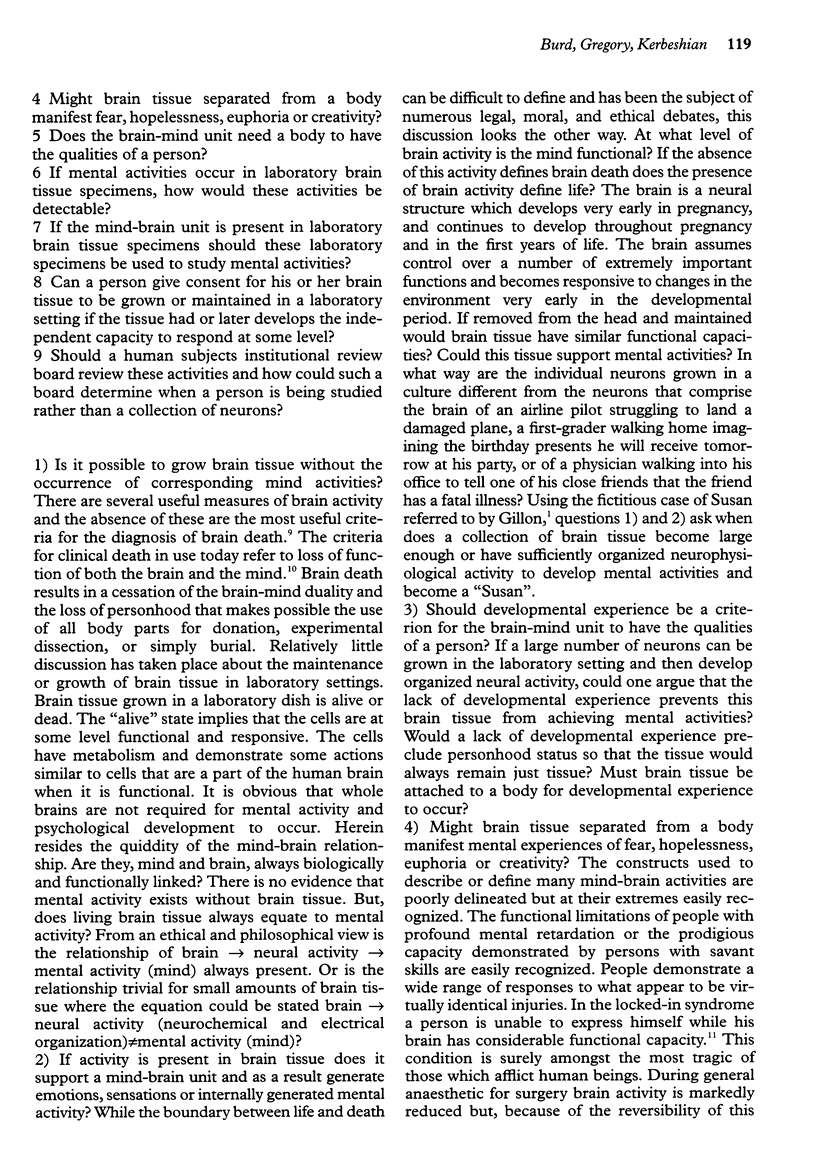Abstract
The use of human brain tissue in neuroscience research is increasing. Recent developments include transplanting neural tissue, growing or maintaining neural tissue in laboratories and using surgically removed tissue for experimentation. Also, it is likely that in the future there will be attempts at partial or complete brain transplants. A discussion of the ethical issues of using human brain tissue for research and brain transplantation has been organized around nine broadly defined topic areas. Criteria for human brain tissue transplantation and laboratory use of brain tissue are proposed.
Full text
PDF




Selected References
These references are in PubMed. This may not be the complete list of references from this article.
- Bernat J. L. Brain death. Occurs only with destruction of the cerebral hemispheres and the brain stem. Arch Neurol. 1992 May;49(5):569–570. doi: 10.1001/archneur.1992.00530290161027. [DOI] [PubMed] [Google Scholar]
- Gillon R. Brain transplantation, personal identity and medical ethics. J Med Ethics. 1996 Jun;22(3):131–132. doi: 10.1136/jme.22.3.131. [DOI] [PMC free article] [PubMed] [Google Scholar]
- Katz R. T., Haig A. J., Clark B. B., DiPaola R. J. Long-term survival, prognosis, and life-care planning for 29 patients with chronic locked-in syndrome. Arch Phys Med Rehabil. 1992 May;73(5):403–408. [PubMed] [Google Scholar]
- Lin L. F., Doherty D. H., Lile J. D., Bektesh S., Collins F. GDNF: a glial cell line-derived neurotrophic factor for midbrain dopaminergic neurons. Science. 1993 May 21;260(5111):1130–1132. doi: 10.1126/science.8493557. [DOI] [PubMed] [Google Scholar]
- Madrazo I., León V., Torres C., Aguilera M. C., Varela G., Alvarez F., Fraga A., Drucker-Colín R., Ostrosky F., Skurovich M. Transplantation of fetal substantia nigra and adrenal medulla to the caudate nucleus in two patients with Parkinson's disease. N Engl J Med. 1988 Jan 7;318(1):51–51. doi: 10.1056/NEJM198801073180115. [DOI] [PubMed] [Google Scholar]
- McMillian M. K., Thai L., Hong J. S., O'Callaghan J. P., Pennypacker K. R. Brain injury in a dish: a model for reactive gliosis. Trends Neurosci. 1994 Apr;17(4):138–142. doi: 10.1016/0166-2236(94)90086-8. [DOI] [PubMed] [Google Scholar]
- Northoff G. Do brain tissue transplants alter personal identity? Inadequacies of some "standard" arguments. J Med Ethics. 1996 Jun;22(3):174–180. doi: 10.1136/jme.22.3.174. [DOI] [PMC free article] [PubMed] [Google Scholar]
- Vining E. P., Freeman J. M., Pillas D. J., Uematsu S., Carson B. S., Brandt J., Boatman D., Pulsifer M. B., Zuckerberg A. Why would you remove half a brain? The outcome of 58 children after hemispherectomy-the Johns Hopkins experience: 1968 to 1996. Pediatrics. 1997 Aug;100(2 Pt 1):163–171. doi: 10.1542/peds.100.2.163. [DOI] [PubMed] [Google Scholar]


